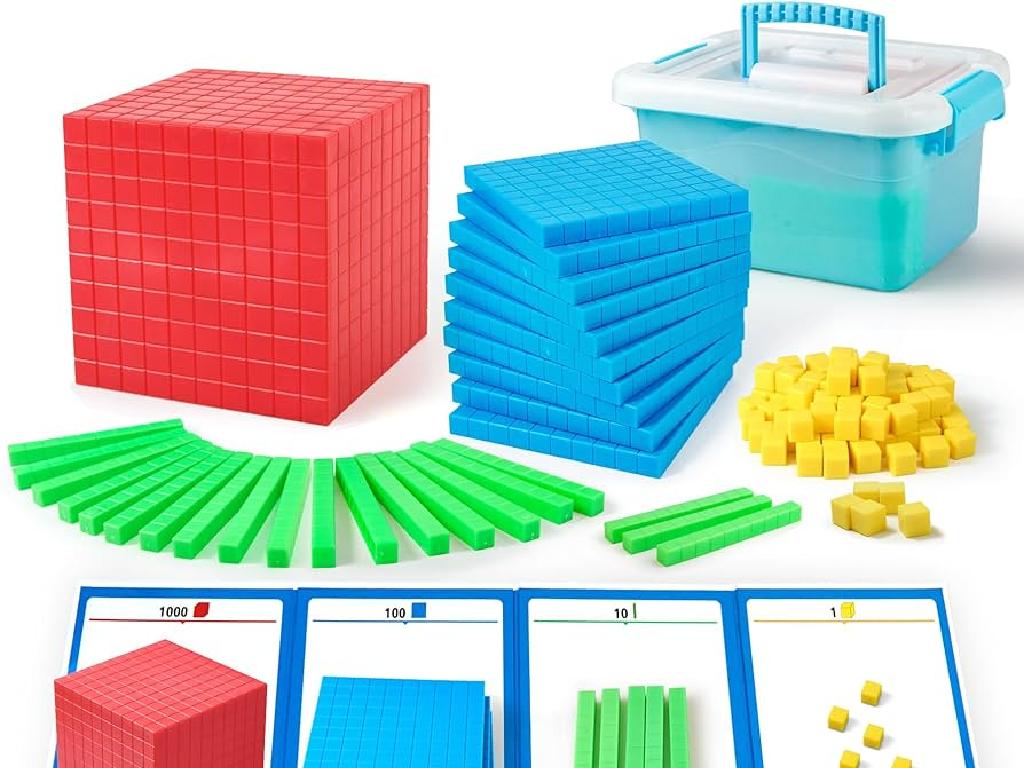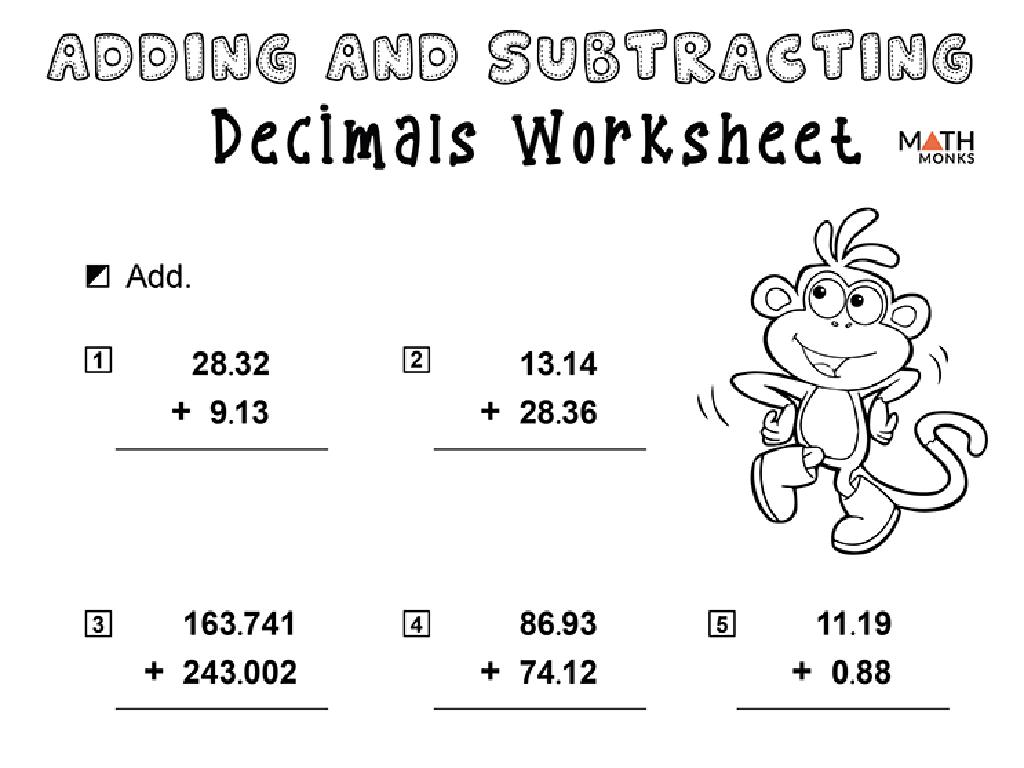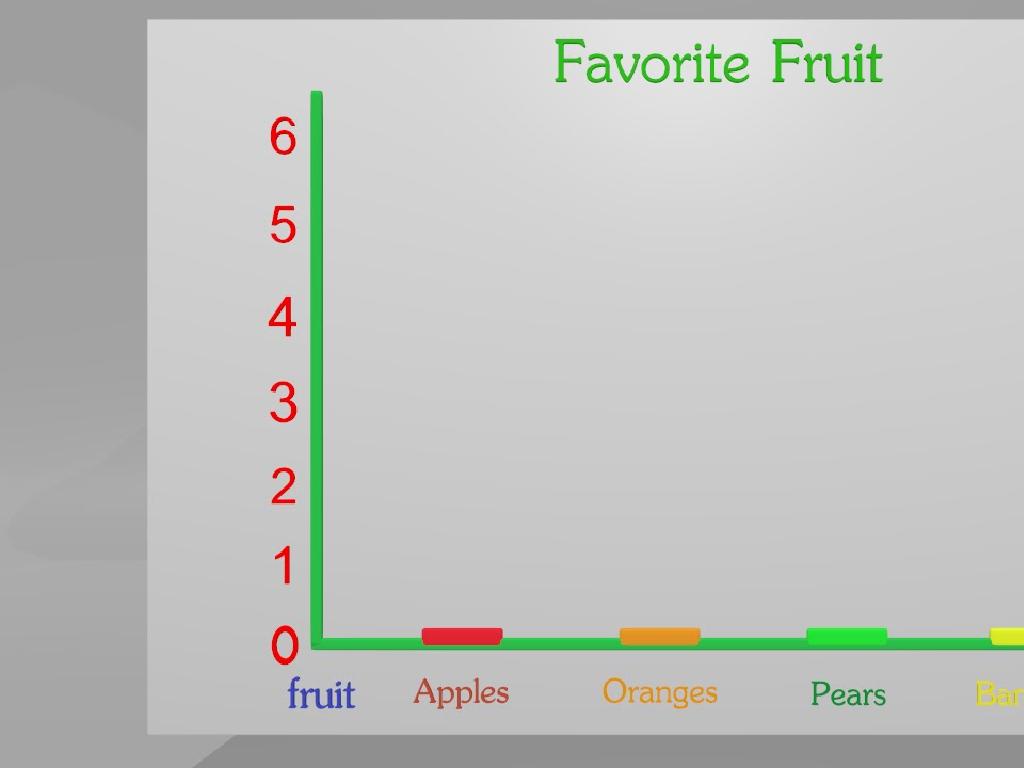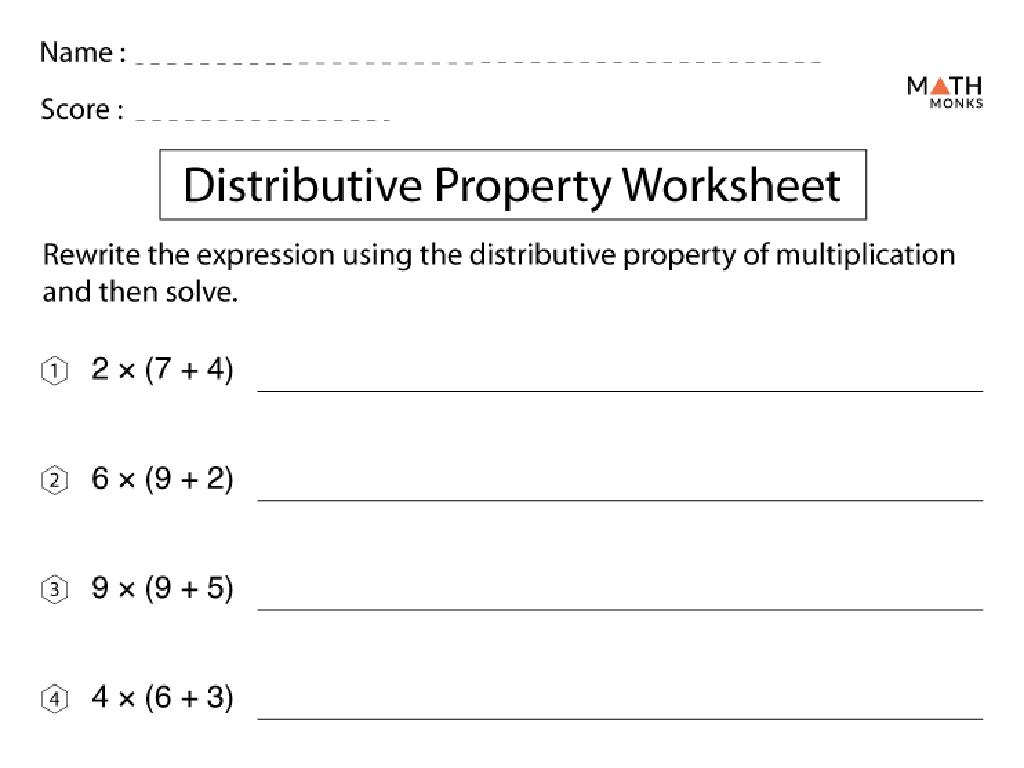Perimeter Of Figures On Grids
Subject: Math
Grade: Fifth grade
Topic: Perimeter
Please LOG IN to download the presentation. Access is available to registered users only.
View More Content
Welcome to Perimeter Exploration!
– Understanding Perimeter
– Perimeter is the total distance around a shape.
– Importance of Perimeter
– Perimeter helps in real-life tasks like fencing a yard.
– Perimeter on Grids
– Use grid lines to count the sides of shapes.
– Today’s Learning Goal
– Learn to calculate the perimeter of various figures on grids.
|
This slide introduces the concept of perimeter, which is a fundamental measurement in geometry. Start by explaining that perimeter is the total length of all sides of a 2D shape. Emphasize the practical applications of perimeter, such as determining the amount of material needed for a fence. Then, focus on teaching how to find the perimeter of shapes on grids, which simplifies the process by allowing students to count the units along the grid lines. The goal for today’s lesson is for students to become comfortable with calculating the perimeter of various figures on grids, preparing them for more complex geometry tasks in the future. Encourage students to think of examples where they might need to measure perimeter in their daily lives.
Exploring Perimeter on Grids
– Perimeter: total distance around a shape
– Calculate by adding all side lengths
– If a rectangle has sides of 4 units and 3 units, its perimeter is 2*(4+3) = 14 units.
– Use appropriate units of measurement
– Common units include meters (m), centimeters (cm), and inches (in).
– Practice with different shapes
– Try finding the perimeter of a square and a triangle on grid paper.
|
This slide introduces the concept of perimeter as a fundamental measurement in geometry, specifically for various shapes on grids. Emphasize that perimeter is the sum of all sides of a shape and can be calculated easily by addition. Highlight the importance of using the correct units of measurement, which can vary depending on the context. Provide examples of calculating the perimeter of common shapes, such as rectangles and squares, and encourage students to practice with different shapes on grid paper to reinforce the concept. This will prepare them for more complex problems involving perimeter.
Perimeter on Grids
– Measure perimeter using grids
– Count squares along shape edges
– If a rectangle has 3 squares on one side and 4 on the other, its perimeter is 14 units.
– Each square equals one unit
– Practice with different shapes
– Try finding the perimeter of a square and a triangle on grid paper.
|
This slide introduces the concept of measuring the perimeter of various shapes using grid paper, which is a visual and interactive method. Emphasize that each square on the grid represents one unit of length, which simplifies the process of finding the perimeter to counting the number of squares along the edges of the shape. Encourage students to practice with different shapes to understand how the perimeter is the total length around the shape. Provide examples of regular shapes like squares and rectangles as well as irregular shapes to challenge the students. During the next class, have a hands-on activity where students use grid paper to draw shapes and calculate their perimeters.
Calculating Perimeter: Rectangles
– Perimeter equals sum of all sides
– Example: Rectangle perimeter
– If a rectangle is 6 units by 4 units, add 6+6+4+4
– Add lengths of opposite sides
– For rectangles, add length and width, then double the result
– Practice: 5 units by 3 units rectangle
– What’s the perimeter of a 5×3 rectangle?
|
This slide introduces students to the concept of calculating the perimeter of a rectangle. Start by explaining that the perimeter is the total distance around the edge of a shape. Use an example to show how to calculate the perimeter by adding the lengths of all four sides. For rectangles, this can be simplified by adding together the length and width and then multiplying by two, since opposite sides are equal. The practice problem involves a rectangle with sides of 5 units and 3 units, which will help students apply the concept. Encourage students to work through the problem and verify their answers with a partner. Provide additional practice problems with different side lengths to reinforce the concept.
Calculating Perimeter: Irregular Shapes
– Example: Perimeter of an irregular shape
– Add up the lengths of all sides to find the total perimeter
– Count the outer grid lines
– Each grid line equals one unit of length
– Practice Problem on a grid
– Use the counting method to solve the provided problem
|
This slide introduces students to the concept of calculating the perimeter of irregular shapes using grid lines. Start with an example, showing an irregular shape on a grid and demonstrate how to add the lengths of the outermost lines to find the total perimeter. Emphasize that each grid line represents one unit of length. Provide a practice problem with an irregular shape on a grid and guide students to apply the counting method to find the perimeter. Encourage students to work through the problem step-by-step and verify their answers with a partner. This activity will help solidify their understanding of perimeter in a practical, visual way.
Let’s Practice Together: Perimeter on Grids
– Find perimeter of grid shapes
– Count the edges of each shape on the grid to find the total perimeter
– Work in pairs for collaboration
– Discuss strategies and check each other’s work
– Share answers with the class
– Explain how you found the perimeter to the class
|
This class activity is designed to reinforce the concept of perimeter in a collaborative and interactive setting. Students will pair up to work on finding the perimeter of various shapes drawn on grid paper. Encourage them to count the number of squares along the edges of each shape to determine the perimeter. Emphasize the importance of double-checking their work with their partner. After completing the activity, each pair will have the opportunity to share their answers and discuss the strategies they used to find the perimeter with the rest of the class. This will help students learn from each other and gain a deeper understanding of the concept. Possible variations of the activity could include using different shapes, introducing irregular shapes, or challenging students to create their own shapes on the grid for others to solve.
Perimeter in Real Life: Planning and Building
– Perimeter’s role in everyday life
– Example: Garden planning
– Measure garden edges to calculate needed materials
– Example: Fence construction
– Determine fence length for enclosing an area
– Practicality of perimeter measurement
|
This slide aims to show students how the concept of perimeter is applied in real-world scenarios, such as planning a garden or building a fence. Understanding perimeter helps in calculating the amount of materials needed for a project. For instance, knowing the perimeter of a garden allows one to purchase the correct amount of fencing. Similarly, when building a fence, the perimeter measurement ensures that the correct length of fencing is installed to enclose a property. Encourage students to think of other areas where they might need to measure the perimeter and discuss the importance of accuracy in these measurements.
Class Activity: Create Your Own Shape
– Draw a shape on grid paper
– Calculate the shape’s perimeter
– Add up the lengths of all sides
– Present your shape and its perimeter
– Discuss perimeter calculation
– Share methods used for calculation
|
This activity is designed to reinforce the concept of perimeter in a fun and interactive way. Provide each student with grid paper and ask them to draw any polygonal shape they like. They should then use what they’ve learned to calculate the perimeter of their shape by adding the lengths of all sides. Encourage creativity in the shapes they create but remind them to keep track of the side lengths. After calculating, each student will present their shape and explain how they determined the perimeter. This will help students practice their presentation skills and allow for discussion on different methods of calculation. Possible variations of the activity could include creating shapes with specific perimeters, comparing perimeters of different shapes with the same area, or finding the perimeter of shapes within shapes.
Wrapping Up: Perimeter Review & Homework
– Recap today’s perimeter lesson
– Complete the perimeter worksheet
– Find the perimeter of various shapes on the grid.
– Introduction to area next class
– Area measures inside of shapes, unlike perimeter.
– Practice makes perfect!
|
As we conclude today’s lesson on the perimeter of figures on grids, remind students of the key points such as how to calculate the perimeter by adding the lengths of all sides. For homework, students will reinforce their understanding by completing a worksheet that includes a variety of shapes on grids. Looking ahead, prepare students for the next lesson on area, which is a different concept that measures the space inside a shape. Encourage students to practice the perimeter problems to build a strong foundation for learning about area.

-a-solution-to-the-linear-equation/linear_equation_graph_solutions.png)



